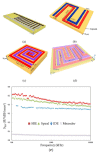Recent Advances in Printed Capacitive Sensors
- PMID: 32244571
- PMCID: PMC7230616
- DOI: 10.3390/mi11040367
Recent Advances in Printed Capacitive Sensors
Abstract
In this review paper, we summarize the latest advances in the field of capacitive sensors fabricated by printing techniques. We first explain the main technologies used in printed electronics, pointing out their features and uses, and discuss their advantages and drawbacks. Then, we review the main types of capacitive sensors manufactured with different materials and techniques from physical to chemical detection, detailing the main substrates and additives utilized, as well as the measured ranges. The paper concludes with a short notice on status and perspectives in the field.
Keywords: inkjet printing; interdigitated electrodes; roll-to-roll; screen printing; spray deposition.
Conflict of interest statement
The authors declare no conflict of interest.
Figures




Similar articles
-
Review of Recent Inkjet-Printed Capacitive Tactile Sensors.Sensors (Basel). 2017 Nov 10;17(11):2593. doi: 10.3390/s17112593. Sensors (Basel). 2017. PMID: 29125584 Free PMC article. Review.
-
3D Printing Technologies for Flexible Tactile Sensors toward Wearable Electronics and Electronic Skin.Polymers (Basel). 2018 Jun 7;10(6):629. doi: 10.3390/polym10060629. Polymers (Basel). 2018. PMID: 30966663 Free PMC article. Review.
-
Printed and flexible biosensor for antioxidants using interdigitated ink-jetted electrodes and gravure-deposited active layer.Biosens Bioelectron. 2015 May 15;67:553-9. doi: 10.1016/j.bios.2014.09.039. Epub 2014 Sep 22. Biosens Bioelectron. 2015. PMID: 25301685
-
Future Thread: Printing Electronics on Fibers.ACS Appl Mater Interfaces. 2024 Feb 14;16(6):7996-8005. doi: 10.1021/acsami.3c15422. Epub 2024 Feb 4. ACS Appl Mater Interfaces. 2024. PMID: 38310570
-
Review of Batteryless Wireless Sensors Using Additively Manufactured Microwave Resonators.Sensors (Basel). 2017 Sep 9;17(9):2068. doi: 10.3390/s17092068. Sensors (Basel). 2017. PMID: 28891947 Free PMC article. Review.
Cited by
-
FBG-Based Sensitivity Structure Based on Flexure Hinge and Its Application for Pipeline Pressure Detection.Materials (Basel). 2022 Aug 17;15(16):5661. doi: 10.3390/ma15165661. Materials (Basel). 2022. PMID: 36013794 Free PMC article.
-
The Role of Interdigitated Electrodes in Printed and Flexible Electronics.Sensors (Basel). 2024 Apr 24;24(9):2717. doi: 10.3390/s24092717. Sensors (Basel). 2024. PMID: 38732823 Free PMC article. Review.
-
Multi-Transduction-Mechanism Technology, an Emerging Approach to Enhance Sensor Performance.Sensors (Basel). 2023 May 3;23(9):4457. doi: 10.3390/s23094457. Sensors (Basel). 2023. PMID: 37177661 Free PMC article. Review.
-
Transducer Technologies for Biosensors and Their Wearable Applications.Biosensors (Basel). 2022 Jun 2;12(6):385. doi: 10.3390/bios12060385. Biosensors (Basel). 2022. PMID: 35735533 Free PMC article. Review.
-
Tactile Sensing for Minimally Invasive Surgery: Conventional Methods and Potential Emerging Tactile Technologies.Front Robot AI. 2022 Jan 7;8:705662. doi: 10.3389/frobt.2021.705662. eCollection 2021. Front Robot AI. 2022. PMID: 35071332 Free PMC article. Review.
References
-
- Fraden J. Handbook of Modern Sensors: Physics, Designs, and Applications. Springer Science & Business Media; New York, NY, USA: 2004.
-
- Wang P., Liu Q. Biomedical Sensors and Measurement. Springer Science & Business Media; New York, NY, USA: 2011.
-
- Bremner D. The Importance of Sensors to the Internet of Things. [(accessed on 28 March 2020)];2015 Available online: https://eprints.gla.ac.uk/105145/
-
- Vetelino J., Reghu A. Introduction to Sensors. CRC Press; Boca Raton, FL, USA: 2017.
-
- Sukhija M., Nagsarkar T. Circuits and Networks: Analysis, Design, and Synthesis. Oxford University Press; New York, NY, USA: 2010.
Publication types
Grants and funding
LinkOut - more resources
Full Text Sources
Other Literature Sources

